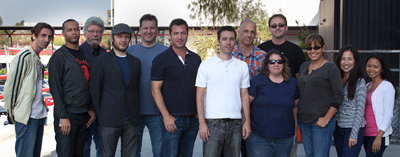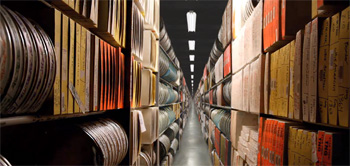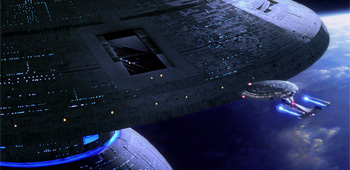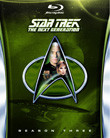A few weeks ago CBS invited TrekCore to talk with the CBS Digital team responsible for the wondrous restoration and remastering of Star Trek: The Next Generation in high definition. Craig Weiss and his team were very generous with their time and answered a huge number of questions, often very technical in nature. I hope you enjoy the resulting interview and leave with a greater understanding and appreciation for the monumental effort that this project represents, and of the wonderfully talented people who are working tirelessly behind-the-scenes to make it happen. Feel free, as usual, to leave comments and questions below.

CBS Digital: TNG Remastered Interview, Part 1
Interviewed by Adam Walker for TrekCore.com
![]()
Craig Weiss: I’ll give you a kind of roster of who we have in the room here. There’s myself, Eric Bruno – who’s our lead compositor, Niel Wray – who’s our head of 3D, Max Gabl – who’s our matte painter and Sarah Paul who is our Overseeing VFX Coordinator on this massive project.
TrekCore: Thanks so much for inviting us to talk to you all. We’ve had such a huge response to the call out for questions – hundreds of emails and questions have come through, and fans are very excited to have their questions answered by you all.
Craig Weiss: We will do our best to answer what we’re involved with and if we don’t have an answer for something, we’ll see if we can find that answer for you.
TrekCore: So I thought we could follow the [remastering] process through chronologically from start to finish. Let’s kick off straight away with talking about the film negatives. Is the film material you are scanning always in the same condition, or do you have to sometimes do more cleaning or baking of the film before it’s useable?
Sarah Paul: The film is not all in the same condition. There are a lot of times where it’s been damaged, and Eric [Bruno] – for instance – on episode 116 with the Starbase, he had to actually go in and fix it. So [the film] has been in all different kinds of stages. Some that looks really good, and some that has sort of been through the bad stages of life.
TrekCore: Is it typically footage which has been used more than once which is likely to be damaged, or is it just arbitrary?
Craig Weiss: Probably arbitrary. I think most… maybe the VFX… it just depends, a lot of the production footage was scanned once or twice and put away in a can in a salt mine for 25 years, so that stuff is remarkably in really great condition. I mean, typically a lot of these shows over the years – every time they wanted a new transfer, they would just run the film through again and again – something like “I Love Lucy” has been through telecining so many times. But Star Trek – actually was pretty much – once it was mastered for the original airing, was put away and I think that’s kind of it.

The sheer scale of the project becomes apparent when you see just how many boxes of reels of film the team have to sift through
Sarah Paul: Occasionally, they would have taken pieces from the film from certain episodes and put it with future seasons and that’s when we’re brought into situations where the film gets lost or misplaced or mislabelled and we’re searching for elements, and those tend to be a little bit more tattered and not in as great shape. For instance, the starbase from one of the movies wasn’t in the best condition…
Craig Weiss: And one more person just joined us – Wendy Ruiz from Mastering
TrekCore: So, continuing on a bit more about the conditions in which the film negatives were stored. What is the implication of that environment on the film after all these years – it’s 25 years for some of the film – with regards to dust and corrosion and fading?
Wendy Ruiz: So far – because of the method of storage – we have not seen any major damage to the elements. It’s more like maybe the cans were a little on the crushed side. The boxes are pretty well intact. There is no real chemical [damage] or seepage – we’re not seeing much of that. The cans are a little bit crushed, the boxes are falling apart. We’re doing a level of triage to the elements where we’re restoring the packaging so that future generations – when they have to go back to the film – it’s in a better condition than we received it in.
TrekCore: What happens to the film itself when it’s been scanned for the remastering?
Wendy Ruiz: We hang on to the film until we no longer need the elements, and then we return it to storage where we’re currently keeping [the film] here in Burbank. Once the project is fully completed, that’s when it will all go back to the salt mines.
TrekCore: Sometimes – and Sarah’s already touched on this – footage is seen from the Star Trek Movies which is reused in TNG, like the Starbase for example. Is it always possible to find this footage, as Paramount is responsible for the motion pictures?
Sarah Paul: You mean like the Starbase from Star Trek III?
TrekCore: Yes, and I know there were a couple of other effects used [apart from the starbase]…
Sarah Paul: Right. Usually what I have to do is contact the Paramount archive… and I tell them what I’m looking for and what scene. They have a catalogue there and they know what I need and they send it over and I put it up, look at it, and if it’s what I need we put it in the show!
TrekCore: Wow, so you scan [these scenes] from the original camera negatives of the movie then?
Sarah Paul: Yes, we do.

To remaster this iconic scene from Season 1’s “11001001”, CBS Digital’s Sarah Paul contacted the Paramount archive and got the original camera negatives from Star Trek III
TrekCore: A question for Sarah. Could you tell us a little bit about the notes you have to interpret. We saw some of these on the bonus features from Season 1. They seem almost like a different language. [How difficult is it] to find the footage and which takes are filed where? Are bits of film strewn everywhere, or are they kept together in their respective episodes?
Sarah Paul: For the most part, they are kept in their respective episodes. But there’s an occasional shot here and there which maybe they shot when they were shooting the next episode, or the previous episode. And sometimes I have to go through the notes, and sometimes it’s just a little bit of a pencil note written in the corner which tells me it was from another episode. So then I’ll have to go through ALL the visual effects O-negs for that episode looking for one particular shot.
TrekCore: The two seconds which were lost from Season One – I still find it remarkable that from the whole first season, you were only missing two seconds. How does that get separated?
Sarah Paul: I think they sent it out to be cleaned. That particular shot.
Wendy Ruiz: That film had been damaged in that particular case. The notes say that it went off to Technicolor and from there there’s no information where it went.
TrekCore: I see, so is that a unique situation or have you encountered the same problems with some of Season 2?
Sarah Paul: Season 1 stuff, yes – there was some stuff where they cut off just one shot, sent it out to be cleaned or fixed and sent it back. But there was always a little note or something telling me what roll it might be on. It’s just that one shot of Riker that I could not find.


